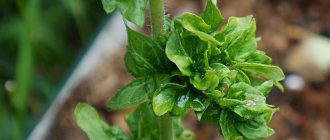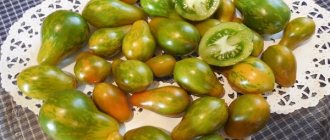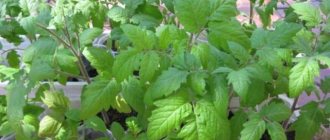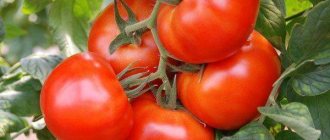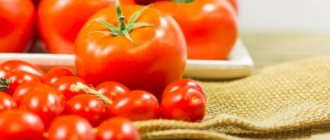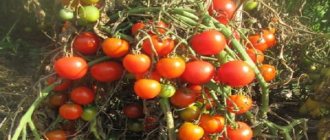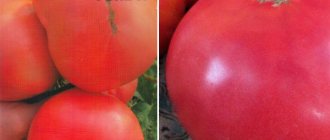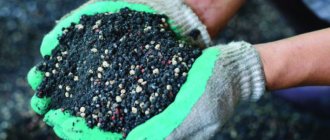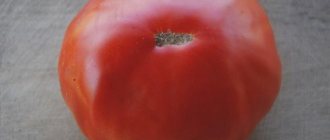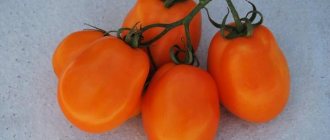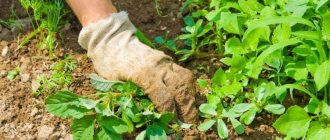Tomato Gavrosh: characteristics and description of the variety
The Gavroche tomato belongs to the semi-determinate type, an ultra-early variety of tomatoes - almost 3 months pass from the moment the seedlings are planted in open ground until harvest. Gavroche is classified as a cherry tomato.
Although this vegetable plant is recommended for cultivation in open ground, many vegetable growers successfully grow Gavroche in greenhouse conditions, greenhouses and even on glazed balconies (or loggias)
, while obtaining good yields of ripe round fruits. The Gavroche tomato has been zoned for cultivation in the southern regions of Russia; it is better to plant this variety in the middle zone and other regions with similar climatic conditions in a heated greenhouse.
The bushes of this vegetable are compact, the shoots reach a height of 0.4-0.6 m. However, with good care of the Gavroche tomato, the stems can grow higher. But according to the manufacturer, even in this case the shoots do not require garter, and there is also no need to remove the stepsons.
The ovaries are collected in racemose inflorescences, each of which can ripen up to 5-6 fruits.
Each raceme is formed through a pair of true leaves. In total, no more than 6 racemose inflorescences are formed on one bush. And the first ovaries usually form above the 4th true leaf.
The emerging stalks always have an articulation. Ripe fruits have a regular round shape and are smooth. The skin is quite dense, not prone to cracking, and has a rich red color.
The weight of the fruit is up to 50 g, the pulp is sweetish in taste, with a characteristic sourness. Each tomato contains 2-3 seed chambers.
Productivity of tomato variety Gavroche
Tomatoes ripen together, so they harvest all at once. From each bush you can collect up to 1.5-1.9 kg. In greenhouse conditions, the yield of Gavroche tomato increases by about a quarter.
The harvested crop has an excellent presentation, good taste, and tolerates transportation well over long distances.
Ripe fruits are versatile: they can be eaten fresh, added to salads or snacks. Housewives say that the taste of ripe Gavroche tomatoes is excellent when pickled or pickled.
Video about tomatoes from the Gavrish company
This vegetable crop is resistant to weather changes, tolerates the rainy season well without reducing yield, and is also resistant to slight cold snaps.
Experts say that the Gavroche tomato is moderately resistant to the tobacco mosaic virus
.
However, if summer residents do not carry out preventive treatment of tomato bushes against cladosporiosis
, then when a plant is infected with this disease, the yield decreases sharply.
Buddy F1
These hybrid tomatoes are a true gardener's dream! They are not only early ripening, but also super-yielding. Moreover, the average weight of one fruit is about 100 g.
In the conditions of the middle zone, Druzhok F1 is recommended to be grown through seedlings, since the plants of this hybrid are quite heat-loving. However, this small drawback is more than compensated by its high resistance to various diseases and viruses.
| Growing | Ripening time (days) | Fruit weight (g) | Productivity (kg per bush) | Peculiarities |
| 90-95 | 90-100 | 3-5 | Resistance to tobacco mosaic virus, fusarium, cladosporiosis | |
Different groups of tomatoes
Tomato fruits of all varieties and hybrids can be divided into several different groups based on weight. These are tomatoes with a fruit weight of 15-30 g - cherry tomatoes. They are closest to the ancient tomatoes, when the presence of a small fruit contributed to survival and its spread. In modern cherry tomatoes, the fruits in the inflorescence are equal in weight, resistant to cracking and have at least 12-14 fruits in the cluster. Cherry tomatoes have a completely unique taste. Typical representatives of cherry tomatoes: Red cherry, Yellow cherry, Winter cherry, Cherry cocktail.
However, there has always been a need for larger and better fruits. The following group has appeared: tomatoes weighing from 30-60 g - cocktail tomatoes. They are characterized by simple long or complex branched inflorescences and fruits of various shapes and colors. These are tomatoes:
Galapagos, Patron, Cio-chio-san.
The next group of tomatoes is racemose with a fruit weight of about 100 g. The fruits in the inflorescence are equal in weight, they are characterized by simultaneous ripening (F1 Intuition).
Regular tomatoes are the most common group with a fruit weight of 120-140 g, a simple inflorescence, high quality fruit, and good storage characteristics:
F1 Evpator, F1 Pharaoh,
F1 Alcazar, F1 Alhambra.
Tomatoes suitable for growing in open ground by direct sowing (seedless method):
Volgogradsky 323, Gifts of the Volga region,
Betta, Alaska,
Early 83, Siberian early ripening,
Newbie, Gavroche,
Parodist, Moment, Pygmy, etc.
There are tomatoes that are easy to grow and do not require pinching. For those who want to get an early, healthy harvest of medium-sized tomatoes without installing protected structures, the following early-ripening varieties and hybrids are suitable:
Agatha, Alaska
Betta, Biathlon,
Bonsai, F1 Blitz, Boni-M. The plants are low-growing, compact, and do not require pinching. Hybrids begin to bear fruit very early, so they can be grown without seedlings - by direct sowing in the ground.
A little about the color of tomatoes and their usefulness. Red and orange fruits and other more unconventional colors are also useful. All brightly colored tomatoes contain carotene and lycopene. Pink-fruited tomatoes contain no less lycopene than red-fruited ones. Lycopene is a powerful biologically active substance with anticancer activity and protective properties against retinal degeneration. Carotene, provitamin A, found in tomato fruits, is a powerful antioxidant involved in many vital processes in the human body.
Which tomatoes are the sweetest? As you know, there is no arguing about tastes, but, of course, cherry-shaped ones are rightfully considered the sweetest. As the size of the fetus increases, so does the size of the cells that make up the fetal tissue. Their water content increases, and as a result, the amount of sugars and acids may decrease. In the fruits of cherry tomatoes, the water content is less, the amount of dry matter is greater, hence the taste is brighter and richer.
Now regarding the suitability of tomatoes for whole-fruit canning. Depending on the tastes of the household, plum-shaped, banana-shaped, pepper-shaped, rounded tomatoes with strong skin, bright color and a small mass that freely fits into the neck of the container are chosen for whole-fruit canning. The best tomatoes are:
De Barao (pink, yellow, red, black - the most beautiful mixture in a jar),
Khokhloma, Chukhloma,
Capia rosea, Banana red,
Baskak, Rocker,
Hyperbole, F1 Kineshma.
Tomatoes differ from each other not only in the type of growth, but also in shape, weight and color.
Intermediate type of inflorescence - 1-2 times branched (cherry-shaped, cocktail), the first inflorescence in some ordinary tomatoes); a complex inflorescence - branched many times (cocktail tomatoes) and a very complex inflorescence - resembling a panicle in appearance.
Varieties for open ground
A huge number of species with excellent yields are intended for growing vegetables in the open air. Low-growing bushes with large fruits are one of the advantages of tomatoes for the soil. Such heat-loving plants are easier to care for and do not require complex agricultural practices.
According to ripening period
Tomatoes, like other vegetable crops, are characterized by different ripening periods, from early to late.
The ripening time, color and shape of tomatoes depends on the variety.
Usually early-ripening vegetables with not large fruits and not a large harvest, but with a quick, friendly yield of ripe tomatoes. Mid-season ones also have medium sizes. Late ones are usually difficult to care for, but it is among them that you can find champions in weight, but there are not many such beauties on the bush.
By growing region
Every year, breeders create new species with high quality indicators. In stores you can buy specialized varieties of tomatoes designed for growing in certain climatic conditions. Classification by regions of Russia:
- for the Moscow region: Champion, Sweet Bunch, Honey, Pink Elephant, Fireworks, Bull's forehead;
- for the southern regions: Torch, Novice, Titan, Winner, Bison, Ermak, Gift, Mikado;
- for the middle zone: Bull's Heart, Black Prince, Uzbek (Yusupov), Moskvichka, Snowdrop, Big Brother, Spasskaya Tower;
- for Siberia: Siberian heavyweight, Ultra early ripening, Sanka, Abakan pink;
- for the Urals: Coin, Bull's Heart, Button, Countryman, Yellow Buyan, Bullfinch, Demidov;
- for the far north: Snowy Tale, Ballerina, Ladyfingers, Berdsky Large, Countryman, Oak, Gina.
An unpredictable, cold or, conversely, excessively warm climate is not a reason to refuse to grow tomatoes in open ground. Thanks to selection, varieties have been developed that grow and develop well in any terrain.
According to disease resistance
To obtain a rich harvest, you need to choose tomato varieties not only with the appropriate characteristics. It is necessary that this criterion be supplemented by such an indicator as disease resistance.
Late blight, root rot, tobacco mosaic, cladosporiosis are diseases that most often affect plantings of heat-loving crops.
A catalog of tomatoes that can withstand the onslaught of various diseases:
- Blitz;
- Koenigsberg;
- Geisha;
- Betta,
- Anyuta;
- Bohemia;
- Chio-chio-san;
- Tatiana;
- Puzata hut;
- Lights of Moscow;
- Yablonka Russia;
- Crimson giant.
Unfortunately, there are no varieties that are 100% resistant to infections. But there are hybrids that produce a harvest until the active phase of many fungal diseases and infections begins.
Care
Further, during the growth of the plant, if necessary:
- tie up;
- stepchildren;
- watered;
- weeding.
The main indicator of the need for watering is dry soil. Tomatoes cannot tolerate soil drying out, so frequent watering and loosening of the soil is necessary. Then the tomatoes will ripen faster and last longer.
Plant fertilizer is applied 3-4 times per season. Organic and mineral fertilizers are used. Plants are fed:
- During the period of seedling growth.
- After transplantation to the main place of growth (after 2 weeks).
- During flowering;
- When the tomatoes ripen.
When fertilizing, plants and fruits receive the nutrients necessary for the growth and ripening of fruits.
It is also important to monitor growth and development. Inspect the bushes
Anyone who has grown tomatoes knows that when rot or gray spots appear on any part of the bush, they are treated with fungicides. Earlier, without waiting for the disease to appear, preventive treatment of plants against diseases is carried out.
With proper care of tomato plants, you will definitely get a rich harvest of juicy and ripe tomatoes.
Leopold F1
The Leopold F1 hybrid is ideal for beginners. The bushes do not require complex care, can withstand low temperatures, produce crops quickly and are not afraid of common tomato “scourges” such as tobacco mosaic virus, fusarium blight, and cladosporiosis.
And, best of all, the tomatoes ripen very large, juicy, and fleshy.
| Growing | Ripening time (days) | Fruit weight (g) | Productivity (kg per bush) | Peculiarities |
| 90-95 | 90-100 | 3-4 | Cold resistance | |
Variety Eagle Heart
The high-yielding variety Eagle Heart (Russia) was pampered with a wall of fruits. The bush is tall, the fruits are pink, heart-shaped, tasty, sweet, dense. By the way, ripe fruits remain on the bush for a long time, remain attractive, retain their presentation, and do not lose their taste and nutritional qualities. Drought- and frost-resistant, resistant to late blight and other common tomato diseases.
The guests who came to see our garden were all, without exception, amazed by the luxurious appearance of the mid-early fruits. And having tried them, they were indescribably delighted and “fell ill” with this variety forever.
Source: sad-dacha-ogorod.com
Semko Sinbad F1
Semko Sinbad is an excellent hybrid for both beginning gardeners and those who grow tomatoes for sale.
The plants practically do not get sick and are unpretentious in care; the fruits have good commercial quality. In addition, these tomatoes are very tasty and juicy.
| Growing | Ripening time (days) | Fruit weight (g) | Productivity (kg per bush) | Peculiarities |
| 85-93 | 85-90 | 2-3 | Disease resistance, good presentation of fruits | |
The best varieties of tomatoes Seeds in stock. Outdoor plants - Kidstaff | No. 21436817
I have come to the conclusion that every year I now grow more and more tall varieties, since they are much more profitable in terms of yield from the same area as low-growing ones, and, of course, I grow those varieties that have conquered their taste qualities and its suitability for canning, freezing and drying.
1. The best varieties of pink - Brandywine, Cuor di Bue Spain (ox heart), Watercolor, Pink honey, Wild rose, Highlander, Samurai, Armenian, Divine early, Sarajevo pink, Abundant Maslova, Kosovo, Raspberry giant, Nobleman, Abakan pink .
The distinctive qualities of tomatoes are: large-sized fruits and amazing taste. It is recommended to eat it fresh, and also use it for making salads, juice, sauce and ketchup.
2. The best varieties of reds - Healthy Life, King of the Early, Lucky Cross, Lou Ji Lai, Samurai, Goose Egg, Matryona, Puzata Khata, Red Coal, King Kong, Gardeners' Delight, British Breakfast, Barberry, Canaries.
The varieties are indeterminate and have a long fruiting period.
Ripening dates are early to mid-early. Plant height is 1.5 - 2 meters. The plant has good immunity and is resistant to late blight. They have high taste qualities.
3. The best varieties of black - Cindao Qingdao or Tsinado, Black pineapple, Chocolate bunny, Tasmanian chocolate, black cherry.
4. The best varieties of green - Aunt Gertie Green, Malachite Box. Vernissage green, Wild thyme, Green lights.
Yes, this is a ripe, but green tomato! The taste is incomparable and beloved! The bushes are tall, more than 1.5 m, grown in one stem. The fruits have a thin skin, which can be easily removed if necessary. The color of ripe tomatoes is green with a yellowish tint. The taste is incomparable. Green-fruited varieties of tomatoes are an excellent substitute for red counterparts for people prone to allergies to them.
5. The best varieties of yellow ones are Reina, Honey King, Grapefruit, Persimmon, Orange German Strawberry, Orange Elephant, Minusinsk Orange Elephant, Thousand Flowers, Heart of Ashgabat, Cream Sauce, King of Siberia.
For lovers of exceptionally tasty fruits. Many years of selection and crossbreeding have resulted in plants that form many tasty fruits with sugary pulp, a very small number of seeds and a wonderful aroma.
The bushes reach a height of one and a half meters. It is grown in 1-2 stems, both in greenhouses and in open ground. Bright orange, fleshy fruits can weigh from 200 to 400 g. They are suitable for canning and preparing preparations.
The juice is also very tasty.
6. The best exotic varieties - Dance with the Smurfs, Bleve medicinal, Violet Jasper, Lilac Lake, Lilac Sunset, Purple Mister USA, Blue Sunlight, Golden Forest Apple Tree, Piedmont, Batyanya of Siberian selection, Firebird Feather, Casady's Madness Casadys Folly.
7.
The best varieties of bicolors are Beauty Queen, Striped Icicle, Alice's Dream, Mister Stripe, Zebra Pineapple, Armenian, Orange Blue, Golden Forest Apple, Reina, Amethyst Jewel, Damascus Steel, Sergeant Pepper, Coal Red, Pink Siberian Tiger, Kasadi Madness, Virginia's Sweets, Hawaiian Pineapple, Gonsior's Hearts, Everett's Rusty Heart, Texas Star, Ezel's Zebra, Canadian Heritage, Summer of Love.
These are rare collectible varieties of two-color and three-color bicolor and tricolor tomatoes, including striped colors - red-orange, black-green interspersed with purple and raspberry blush, they look like toys. These tomatoes also have an unusual coloring of the pulp, they have a rich, juicy aromatic taste.
Good in salads and juices, for preparations and fresh. In terms of taste, two-color and three-color varieties deserve the highest tasting rating; the fruit occupies almost the entire space of the fruit (the seed chambers are very small).
Description in more detail by variety
https://www.kidstaff.com.ua/tema-29440272.html
Tomato Gavrosh: characteristics and description of the variety
Russian Gavroche tomatoes have been known to connoisseurs and gardening enthusiasts since the late 90s. The variety owes its appearance to scientist-breeders of the famous agro. Cute plants with decorative, tasty small fruits are in great demand and now do not need advertising. However, beginners who want to quickly grow high-quality sweet fruits need to learn more about the characteristics of the variety.
Tomato Gavrosh: characteristics and description of the variety
Initially, the variety was created for cultivation in open ground in conditions with a mild climate, without sudden temperature changes, so in the northern and northwestern regions it is planted in various types of greenhouses.
The variety is ultra early ripening. From the moment the seedlings sprout to the first fruits, only 80-85 days will pass. Thus, having sowed the seeds in April, you can already taste the harvest at the end of June.
The fruits are small, bright, round cherry tomatoes when ripe reach a weight of no more than 50 grams. Very sweet and fleshy, with a small amount of seeds. The skin is elastic and thin.
Several pieces ripen in a bunch (no more than six). Typically, each bush has six bunches of fruit, ideal for fresh consumption and canning. A glass jar filled with neat toy fruits will perfectly complement the menu during the cold season.
Note! The semi-determinate tomato grows only half a meter in height and, according to reviews from gardeners, does not need staking. Productivity - up to 1.5 kg per bush
This is a good harvest for such compact plants. Moreover, they ripen early, the bush gives all its strength and within two weeks the fruits ripen completely. After harvesting, the plants are removed from the greenhouse or garden bed
Productivity - up to 1.5 kg per bush. This is a good harvest for such compact plants. Moreover, they ripen early, the bush gives all its strength and within two weeks the fruits ripen completely. After harvesting, the plants are removed from the greenhouse or garden bed.
This variety provides not only for cultivation in industrial quantities, but also for cultivation in a limited space. A solid harvest can be harvested even on the balcony!
Note! The Gavroche tomato variety hardly gets sick. The variety is resistant to common tobacco mosaic, but is susceptible to cladosporiosis - brown spot - affecting both leaves and fruits
However, preventive measures will protect you from harm. To provide plants with immunity, you need:
The variety is resistant to the common tobacco mosaic, but is susceptible to cladosporiosis - brown spot - which affects both leaves and fruits. However, preventive measures will protect you from harm. To provide plants with immunity, you need:
- observe crop rotation;
- plant no more than 4-5 plants per 1 square meter (dense plantings prevent ventilation);
- spray the plant with Bordeaux mixture;
- do not over-moisten the soil.
And, of course, “laying the foundation” occurs when:
- seed selection;
- their disinfection and hardening;
- preparing the soil for sowing - this variety tolerates loose and light soil best. Loam is too much of a challenge for him.
When planting, the seeds should be buried 1-1.5 cm, and after a week they should be fertilized with diluted mullein.
Picking is done after two leaves appear.
Gavroche tomato seedlings, reaching 30 cm in height, are planted in the garden bed. It should not be overgrown in pots - it stretches out, becomes thinner, and becomes frail, which will immediately affect the yield.
Attention! Before planting in a greenhouse or garden bed, it is important not to forget to harden the seedlings in the fresh air for a week, gradually increasing the time spent there. Humus and nitrogen fertilizer must be added to each hole.
Humus and nitrogen fertilizer must be added to each hole.
Plants require moderate watering - only when the top layer of soil dries out, in the evening or early in the morning. The water should not be cold.
Despite the fact that the bushes are small, pinching should still be carried out, especially on the lower shoots.
Regular weeding of the beds will eliminate possible diseases. A couple of times a week you need to remove all small weeds that appear.
During the flowering period, fertilize the bushes with potassium fertilizer (potassium sulfate or ash). Apply the third fertilizing with complex fertilizer during the period of fruit formation.
A description of the Gavroche tomato variety will help lovers of this vegetable decide on the choice of seeds for the next season.
Biathlon F1
This hybrid has a lot of advantages: it is ultra-early, produces a large harvest of large, fleshy tomatoes and practically does not get sick.
READ MORE: Leningrad chilli tomato characteristics and description of the variety with photos
Biathlon F1 tomatoes can be either grown through seedlings or sown in open ground. Depending on the weather, seedlings are planted or seeds are sown in the ground from the first ten days of May to early June.
| Growing | Ripening time (days) | Fruit weight (g) | Productivity (kg per bush) | Peculiarities |
| 80-85 | 80-100 | 3-3,3 | Resistance to tobacco mosaic virus and fusarium | |
Diseases and pests
Being a hybrid, the Dobry f1 tomato has increased resistance to many diseases - fusarium, tobacco mosaic virus. However, like all tomatoes, it is susceptible to other diseases, including late blight. Fitosporin or treatment with copper-containing preparations are used as a preventative measure to combat it.
To reduce the likelihood of infections in the greenhouse, it is recommended to carry out the following treatment every autumn:
- Clear the greenhouse area of plant debris.
- Disinfect the walls, frame of the greenhouse, and all auxiliary equipment with a solution of laundry soap.
- Treat the soil in the greenhouse with biological products - “Fitosporin”, “Shine -1” or chemicals - potassium permarganate, Bordeaux mixture.
- Treat the soil with lime and dolomite flour.
- Sow herbs – mustard, phacelia.
Carrying out these measures in the fall will reduce the number of harmful bacteria that actively reproduce in favorable conditions. Tilling the soil will also help in the fight against pest larvae inhabiting the greenhouse.
Tomatoes are affected by the following pests: slugs, spider mites, and Colorado potato beetles. To combat them when they appear en masse, there are many chemicals, but usually gardeners prefer folk remedies - infusions of dandelion, garlic, hot pepper.
Indeterminate and semi-determinate tomatoes: what they are and the best varieties
Now you need to figure out what they are - indeterminate varieties of tomatoes. This is a group of plants with unlimited growth. The first inflorescence is formed at the level of the 8-11th leaf and then every three leaves. Indeterminate tomatoes form many side shoots (stepchildren) on the main stem, which should be removed. This provides a surge of nutrition to the fruits and increases their productivity.
This group includes both mid-season and late-ripening tomatoes. This is the most widespread group of tomatoes. The height of the inflorescences is 8-9 leaves, the inflorescences are located on the plant through three leaves, growth is unlimited. Plants of this type are capable of growing under conditions for more than 8-9 months and are intended for cultivation in film and glass greenhouses. The diversity of this troupe is very great. The best indeterminate varieties and hybrids of tomatoes also include plants with elongated fruits:
Chukhloma and Khokhloma,
Rosemary, Cio-chio-san
Capia rosea,
and large-fruited F1 Krasnobay, F1 Russian size, F1 Grandmother's gift.
They also include De Barao (red, gold, pink (with a “spout”), black, orange) and De Barao Giant from the “Lucky Seeds” series.
Another group is semi-determinate tomato varieties: what are they? This is an intermediate group between tomatoes with limited and unlimited growth patterns. Inflorescences are laid at the height of the 8-9th leaf, then follow through 2-3 leaves, plant growth is limited after the 9-10th inflorescence. This group includes plants of medium ripening with good quality fruits intended for cultivation in protected soil. Popular varieties of semi-determinate tomatoes include:
La-la-fa, Blagovest, Verlioka plus and others.
Ryzhik F1
Hybrid tomatoes Ryzhik F1 - large, fleshy, appetizing orange in color - just begging to be served to the table!
Plants are suitable for growing in open ground. Seeds can be sown as early as early April.
Considering that tomatoes are heavy, Ryzhik’s bushes, like Leopold’s and La-la-fa’s, must be tied up.
| Growing | Ripening time (days) | Fruit weight (g) | Productivity (kg per bush) | Peculiarities |
| 100-108 | 110-120 | 2,3-2,5 | Resistance to late blight | |
History of the variety's creation
This ultra-early tomato variety was created by Russian breeders from the agrotechnical company Gavrish at the end of the last century.
Tomato Gavroche photo
This company is new to the seed and breeding market, it was created in 1993, but its seeds and new varieties of vegetables, bred by the specialists of this company, are in demand not only among Russian farmers, but also abroad.
The Gavroche tomato was included in the State Register in 1997. These tomatoes are recommended to be grown in open ground beds on small farms and in garden plots.
This is interesting: Wild rose tomato: expert advice
Betta F1
Hybrid Betta F1 is classified as an ultra-early tomato variety. Betta fruits ripen 85 days after sowing the seeds, that is, approximately in mid-June.
Seeds are sown in the first ten days of April, and seedlings are planted in the ground in early May. Like Alaska, Betta F1 can be sown in open ground under cover.
| Growing | Ripening time (days) | Fruit weight (g) | Productivity (kg per bush) | Peculiarities |
| 85 | 40-50 | 2-2,5 | High yield | |
The best large-fruited tomatoes: the largest varieties of tomatoes and their photos
Previously, those varieties whose fruit weight was over 120 g were classified as large-fruited tomatoes. Now tomatoes weighing more than 200-250 g are classified as large-fruited.
As can be seen in the photo, the fruits of large varieties of tomatoes are usually flat-round or flat, multi-chambered, fleshy, red or pink, tall and late-ripening:
But among this group there are earlier and shorter ones. The earliest large-fruited tomato is Jane, which combines early ripening, short stature and large-fruited. And already well-known tall hybrids:
F1 Krasnobay, F1 Grandmother's Gift,
F1 Russian size, F1 Matryoshka allow you to get fruits from 200 to 600 g, and with good shaping and care, even more.
With such a huge variety of varieties of good large-fruited tomatoes, the choice is yours.
Large tomatoes can be obtained by rationing the inflorescences, that is, pinching off the brushes and leaving 2-3 fruits in them. The best large varieties and hybrids are suitable for these purposes:
tomatoes, like F1 Krasnobay, F1 Grandma's Gift,
Russian is delicious, Jane,
F1 Funtik, F1 Bityug,
F1 Rosemary, Pelageya,
Akulina, Gorlinka,
Blush, Chubby, F1 Rosebeef.
The most delicious large-fruited tomato varieties are shown in these photos:
Advantages and disadvantages
Every plant has its pros and cons. Pervoklaska tomatoes are no exception, about which there are many reviews and photos, more positive than negative.
Advantages:
- bright, sweet, expressive taste;
- early maturation;
- uniform yield of the harvest - fruits on several clusters ripen almost simultaneously;
- high productivity;
- good keeping quality;
- excellent transportability;
- long fruiting period.
But besides the wonderful advantages, the tomato also has disadvantages:
- determinacy can limit the growth of the bush, additional brushes will stop forming, which will limit the yield;
- demands for more enhanced mineral nutrition;
- susceptibility to diseases, in particular late blight.
Limiting the growth of the bush, of course, limits the number of fruits, but the high yield of the variety, smooth ripening and excellent taste of tomatoes still delight those who like to eat aromatic pink sweet tomatoes.
La-la-fa F1
The fruits of this hybrid are real “strong” (the average weight of one fruit is 150 g). This characteristic alone deserves to plant several bushes of these tomatoes in your garden. By the way, you can collect about 3-4 kg of fruits from one plant.
READ MORE: Large perennial garden chamomile: planting and care
La-la-fa F1 tomatoes are grown in greenhouses and hotbeds; grown seedlings are planted in a permanent place in early - late May. These tomatoes are practically not afraid of the tobacco mosaic virus and are perfectly stored.
Given the considerable weight of tomatoes, the bushes must be tied up during the fruiting period.
| Growing | Ripening time (days) | Fruit weight (g) | Productivity (kg per bush) | Peculiarities |
| 100-105 | 140-160 | 3-4 | Resistant to tobacco mosaic virus, good shelf life | |
